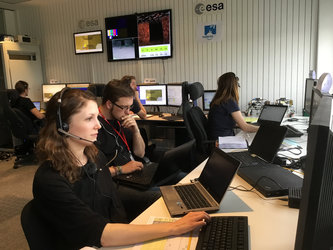Virtual Spacecraft
Enhanced Monitoring & Diagnostics through Virtual Reality
As mission complexity increases, current users demand tools to support the analysis and assessment of spacecraft statuses, and to quickly obtain a 'global view' of what is happening on board. We propose use of mixed reality (MR) technology to provide colour-coded synthesised representations of key telemetry parameter values mapped to the 3D physical model of the satellite. This provides a quick overview of the current health and can support anomaly investigations. This approach was, in a simplified form, used to visualise the Ulysses spacecraft thermal configuration.
Keywords: monitoring, diagnostics, virtual reality
Results
Users get a quick overview of the current state of health of the S/C and an intuitive understanding of on-board activities. This can specifically support anomaly investigation. On-board activities can be monitored in near real-time or playback. A prototype focused on the thermal subsystem has been implemented for Smart-1 and Rosetta ESA missions.
Technology
Virtual Reality Modelling techniques for the visualisation and MUST (Mission Utilities Support Tools) for accessing spacecraft data.
Development Team
The Virtual Spacecraft has been developed by our group.
Description
Housekeeping Telemetry is presently stored as Virtual Environments (VEs) allow humans to visualise, manipulate and interact with computer models. These VEs may be CAD models, scientific visualisations or any other 3D models, and the user can interact and directly manipulate objects within the VE. Nowadays, VE is a consolidated technology in many areas, e.g. industrial design, communications, scientific research, training, education and entertainment. It is especially beneficial in critical or hazardous environments, where human access is not possible. We especially observe remarkable benefits of VEs in industrial design since they bring cost reduction and permit to develop and simulate more interactively, maximising the participation during this phase. This is the main reason why VEs have been exploited over last years in aerospace design and manufacturing.

In this particular case, we apply Mixed Reality (MR) in spacecraft (S/C) operations in order to compensate for the lack of physical contact with the S/C after launch. MR combines VEs with the telepresence concept, which links remote sensors in the real world with the senses of a human operator.
In this research, we aim to map essential S/C data obtained from telemetry, e.g. sensor readings, to the virtual representation. This data is generated by on-board sensors and other components, and it is down-linked through ESA ground segment infrastructure to the mission control system.
On ground, S/C operators use this information to monitor and control the S/C's state of health. With this innovative approach, an added value is provided to mission control by enhancing the perception and understanding of on-board activities using MR techniques. First, this may facilitate daily tasks like monitoring the S/C status and behaviour.
Second, it may support anomaly investigation and resolution since it provides a global and dynamic representation of the system together with the local view of the subsystems or units. Moreover, the virtual S/C can support the training of S/C operators. Another potential use, and an ongoing activity, is the use of VEs for ESOC’s Public Relations events for more intuitive understanding of the on-board activities.
A typical S/C is composed of several complex subsystems, e.g. attitude and orbit control, electrical and power, thermal, communications or data handling and processing. The focus was on the most dynamic subsystem, the thermal subsystem, which is monitored by an enormous amount of distributed sensors.
The application gives a global picture of the thermal status, allowing engineers to quickly visualise which parts of the S/C are within the operational thermal constraints. A follow-on R&D activity is to include other non-thermal sensory data on the 3D environment (e.g. Fig. 1 shows that Smart-1 AMIE camera is switched off in grey colour).
Publications
- Quintana M., Donati, A. Martinez-Heras, J.A.; Virtual Reality and Artificial Neural Networks collaboration for spacecraft behaviour prediction and status display. Proceedings of the SESP conference in Noordwijk, The Netherlands, 2004.
- Donati, A., Martínez-Heras, J.A., Nunes, P., Torrão, R.; Virtual Reality for Monitoring Spacecraft Thermal Subsystem. Concept & Prototype. In SpaceOps 2004, Montréal, Canada, poster 270-120, May 17-21, 2004















 Germany
Germany
 Austria
Austria
 Belgium
Belgium
 Denmark
Denmark
 Spain
Spain
 Estonia
Estonia
 Finland
Finland
 France
France
 Greece
Greece
 Hungary
Hungary
 Ireland
Ireland
 Italy
Italy
 Luxembourg
Luxembourg
 Norway
Norway
 The Netherlands
The Netherlands
 Poland
Poland
 Portugal
Portugal
 Czechia
Czechia
 Romania
Romania
 United Kingdom
United Kingdom
 Slovenia
Slovenia
 Sweden
Sweden
 Switzerland
Switzerland
































